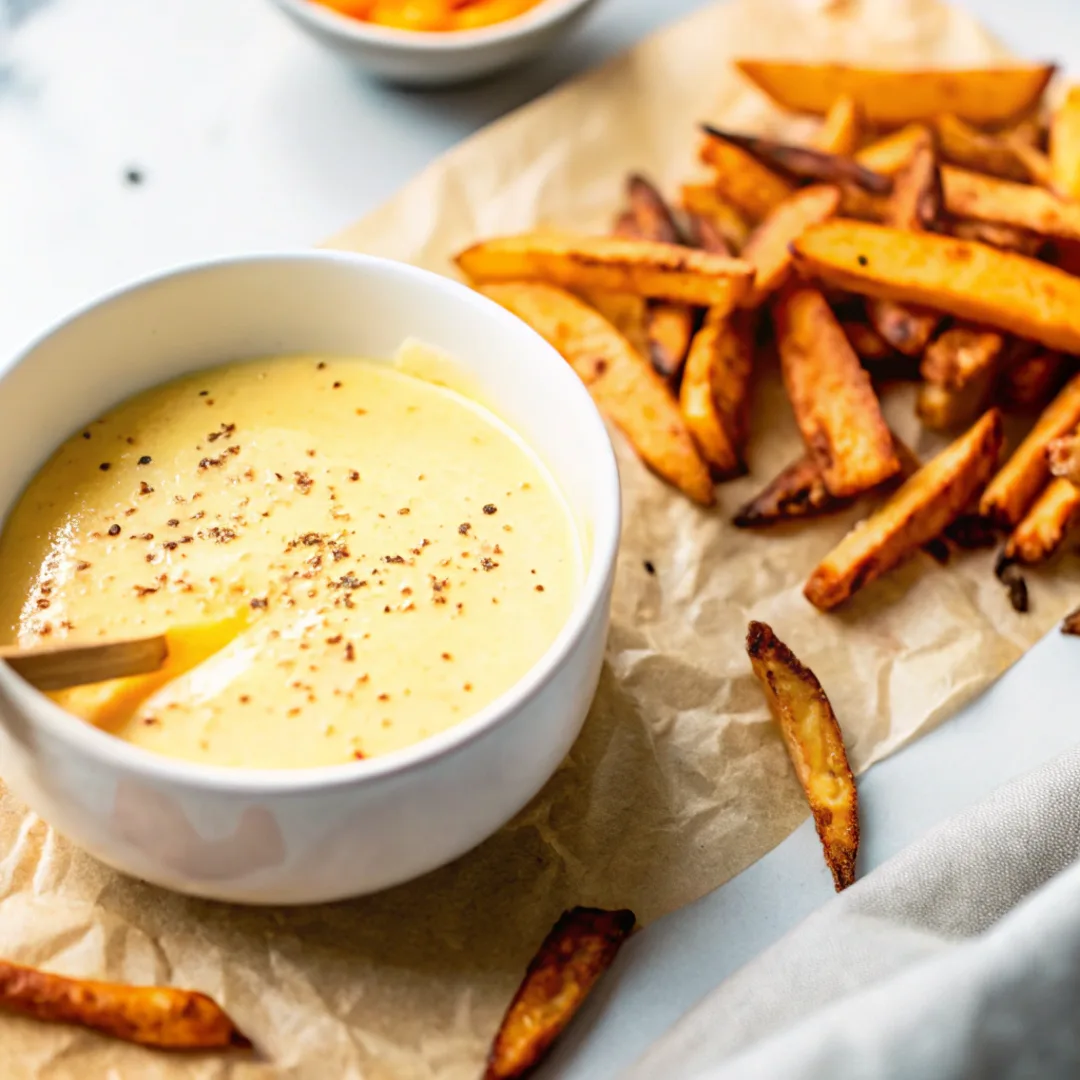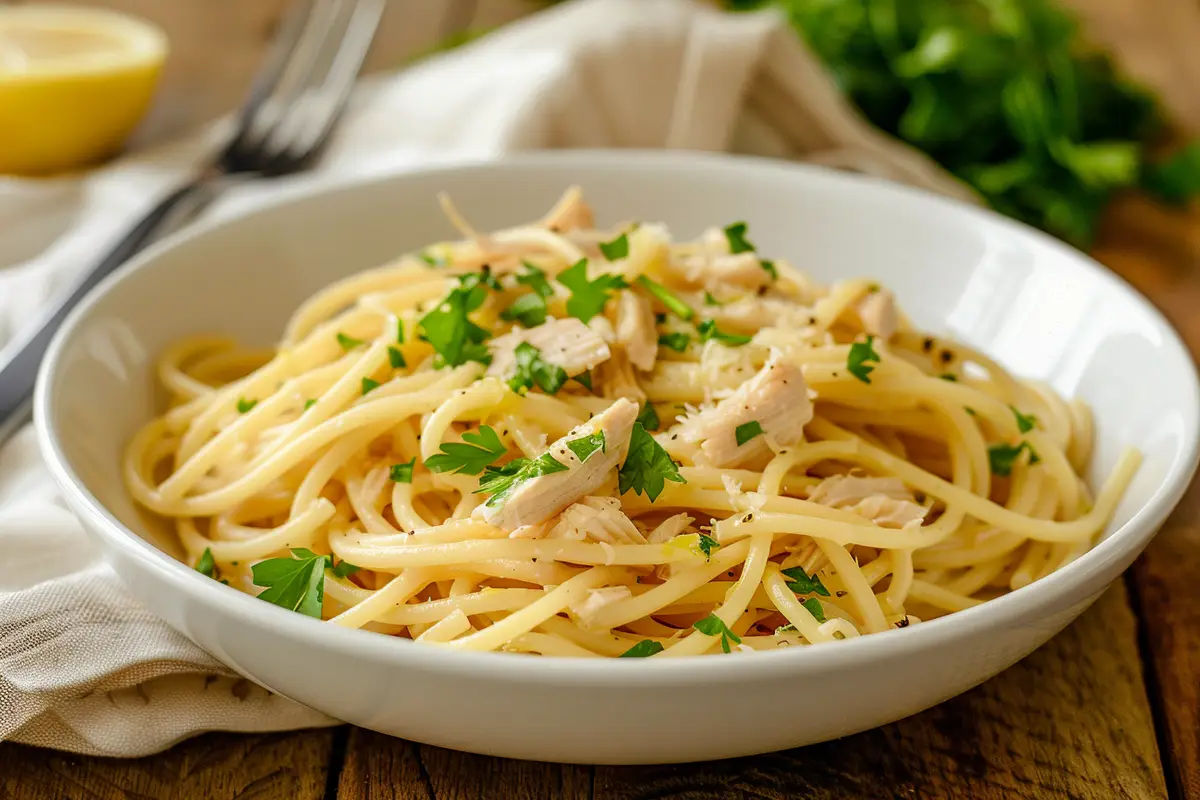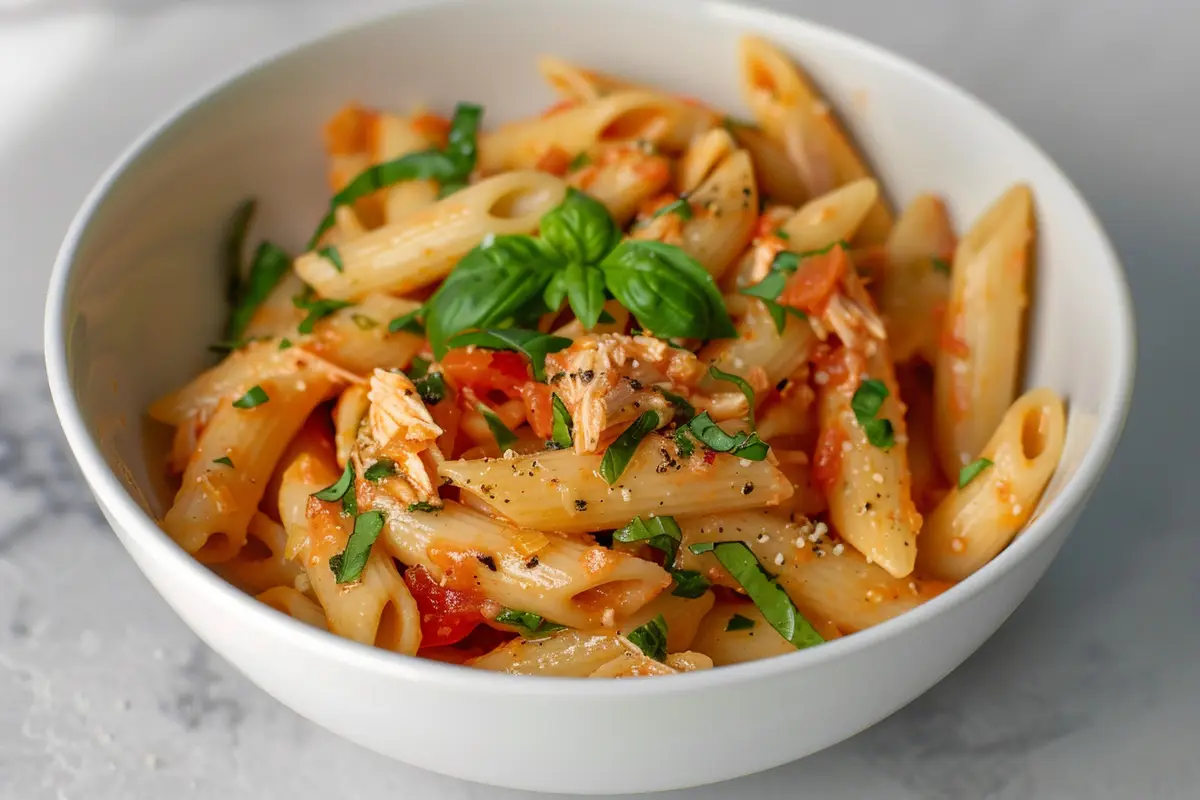Making a vegan cheese sauce recipe is a game-changer for plant-based cooking. This creamy, dairy-free alternative is versatile and delicious, perfect for pasta, nachos, and countless other dishes. Whether you’re new to vegan cooking or a seasoned plant-based foodie, learning how to make a homemade vegan cheese sauce is a must. In this guide, we’ll cover everything you need to know—from key ingredients to step-by-step instructions—to ensure your sauce turns out rich, cheesy, and satisfying every time. Let’s get started!
Table of Contents

Vegan Cheese Sauce Recipe: The Ultimate Guide for a Creamy, Dairy-Free Sauce
- Total Time: 25 minutes
- Yield: Approximately 2 cups of sauce 1x
Description
This creamy vegan cheese sauce is the ultimate plant-based alternative to traditional cheese sauce. Made with simple ingredients like cashews, potatoes, carrots, and nutritional yeast, it’s rich, cheesy, and completely dairy-free. Whether you drizzle it on nachos, toss it with pasta for a comforting vegan mac and cheese, or use it as a dip for veggies, this versatile sauce is a must-have in every plant-based kitchen. Plus, it’s easy to customize for spicy, smoky, or herb-infused variations!
Ingredients
- 1 cup raw cashews (soaked for 10–15 minutes) or 1 cup boiled potatoes and carrots
- 3 tablespoons nutritional yeast
- 1 teaspoon garlic powder
- 1 teaspoon onion powder
- ½ teaspoon smoked paprika
- 1 tablespoon lemon juice
- ½ cup water or unsweetened plant-based milk
- Salt to taste
Instructions
- Prepare the Ingredients:
- If using cashews, soak them in hot water for 10–15 minutes to soften. If using potatoes and carrots, boil them until tender. Drain and set aside.
- Blend the Sauce:
- Add all the prepared ingredients to a high-speed blender. Blend until smooth and creamy, stopping to scrape down the sides as needed.
- Adjust Consistency:
- If the sauce is too thick, add more water or plant-based milk one tablespoon at a time. Blend again until you reach the desired consistency.
- Taste and Adjust Flavor:
- Taste the sauce and adjust the seasoning. Add more nutritional yeast for extra cheesiness or an extra splash of lemon juice for tanginess.
- Serve and Enjoy:
- Use the sauce immediately or store it in an airtight container for later use.
Notes
- Nut-Free Option: Replace cashews with boiled potatoes and carrots for a lower-fat, nut-free version.
- Spicy Variation: Add a dash of cayenne pepper or diced jalapeños for a nacho-style spicy sauce.
- Smoky Flavor: Blend in a chipotle pepper in adobo sauce and a splash of liquid smoke for a bold, smoky twist.
- Storage Tips: Store in an airtight container in the refrigerator for up to 5 days or freeze in portions for up to 3 months. Reheat gently over low heat, stirring continuously for a smooth texture.
- Prep Time: 15 minutes
- Cook Time: 10 minutes
- Category: chef’s choice
- Method: Sauce / Condiment
- Cuisine: Vegan / Plant-Based
Nutrition
- Serving Size: 4 servings
- Calories: ~120
- Fat: ~8g
- Carbohydrates: ~ 8g
- Protein: ~4g
What is Vegan Cheese Sauce?
Understanding Vegan Cheese
Vegan cheese sauce is a dairy-free alternative made with plant-based ingredients like nuts, vegetables, and nutritional yeast. Unlike traditional cheese sauces, this version is completely free of animal products. What makes a vegan cheese sauce recipe unique is its ability to mimic the creamy texture and savory flavor of traditional cheese without the cholesterol and saturated fat found in dairy.
For many plant-based eaters, this sauce becomes a staple in the kitchen. You can use it in various dishes, from vegan mac and cheese to drizzling over steamed vegetables or using it as a dip for fries. The versatility of a vegan cheese sauce recipe makes it a favorite among vegans and non-vegans alike.
Popular Uses for Vegan Cheese Sauce
A vegan cheese sauce recipe can elevate any meal. Here are a few popular uses:
- Vegan Nachos: Drizzle over tortilla chips and top with jalapeños and salsa.
- Pasta Sauce: Turn it into a creamy vegan mac and cheese.
- Vegetable Dip: Serve with roasted broccoli or cauliflower.
- Baked Potatoes: Use it as a topping for loaded baked potatoes.
Why Choose Vegan Cheese Over Dairy?
Switching to a vegan cheese sauce isn’t just a choice for those following a plant-based diet. It’s also a healthier alternative for anyone looking to reduce saturated fat intake and avoid lactose. Many people find that a homemade vegan cheese sauce recipe is more digestible and offers a surprising depth of flavor.
Essential Ingredients for Vegan Cheese Sauce
Base Ingredients: Cashews, Potatoes, and Carrots
The foundation of a great vegan cheese sauce recipe often starts with simple, whole-food ingredients. Cashews are a popular choice due to their natural creaminess when blended. For a nut-free version, potatoes and carrots can be used to create a smooth and thick sauce. These vegetables also add a touch of sweetness and color to the sauce.
Nutritional Yeast: The Secret to Cheesy Flavor
Nutritional yeast is an essential ingredient in any vegan cheese sauce recipe. This deactivated yeast is known for its savory, umami-rich flavor that closely resembles cheese. It’s also packed with B vitamins, making it a nutritious addition.
Herbs, Spices, and Flavor Boosters
To create a truly flavorful vegan cheese sauce recipe, you’ll need the right blend of spices. Common choices include garlic powder, onion powder, smoked paprika, and turmeric for a golden color. Lemon juice or apple cider vinegar adds tanginess, while miso paste or mustard can boost umami.
Common Substitutes and Alternatives
If you don’t have cashews, other nuts like almonds or macadamias can work well. For a low-fat option, try using white beans or silken tofu. Each alternative brings a unique texture and flavor to your vegan cheese sauce recipe.
PART 3: Step-by-Step Guide to Making Vegan Cheese Sauce
Preparing the Ingredients
Before you start blending, it’s essential to prepare your ingredients. Soak cashews in hot water for 10–15 minutes to soften them, which ensures a smoother texture. If you’re using potatoes and carrots, boil them until tender.
Here’s what you’ll need for a basic vegan cheese sauce recipe:
- 1 cup of soaked cashews (or boiled potatoes and carrots)
- 3 tablespoons of nutritional yeast
- 1 teaspoon of garlic powder
- 1 teaspoon of onion powder
- 1/2 teaspoon of smoked paprika
- 1 tablespoon of lemon juice
- 1/2 cup of water or plant-based milk
Blending for a Perfect Texture
To achieve the perfect texture, add all the prepared ingredients to a high-speed blender. Blend until smooth and creamy, stopping to scrape down the sides as needed. If the sauce is too thick, add more water or plant-based milk one tablespoon at a time. The key to a perfect vegan cheese sauce recipe is blending until the mixture is silky smooth.
Adjusting Consistency and Flavor
After blending, taste the sauce and adjust the seasoning. Add more nutritional yeast for a stronger cheesy flavor or an extra splash of lemon juice for tanginess. If the sauce is too thick, thin it out with more liquid; if it’s too runny, return it to the blender and add a boiled potato or a handful of soaked cashews.
Pro Tips for Creamier Sauce
- Use a high-powered blender for the smoothest results.
- For a richer flavor, toast the nutritional yeast before blending.
- Add a pinch of turmeric for a vibrant yellow color without altering the taste.
- A touch of vegan butter can add an extra layer of creaminess to your vegan cheese sauce recipe.
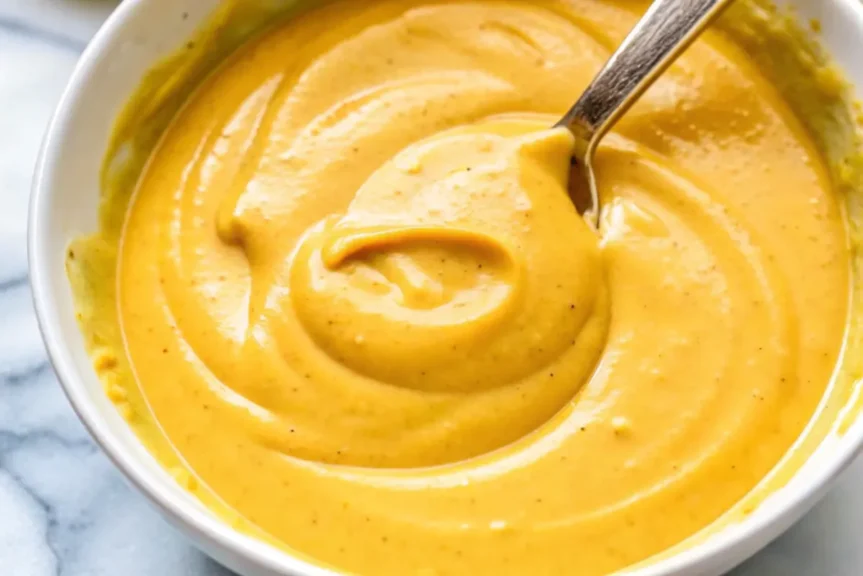
Variations of Vegan Cheese Sauce
A good vegan cheese sauce recipe can be customized in many ways to fit your taste preferences or dietary needs. Whether you want it spicy, smoky, or herb-infused, there’s a variation for everyone. Here are some popular twists on the classic recipe.
Spicy Nacho Cheese Sauce
If you love a little heat, this variation is for you. Add diced jalapeños, a dash of cayenne pepper, and chili powder to your vegan cheese sauce recipe. This spicy version is perfect for nachos, tacos, or dipping tortilla chips.
- Optional add-ins: Hot sauce, roasted red peppers, or chipotle powder for a smoky kick.
Garlic and Herb Vegan Cheese Sauce
For a more savory, herbaceous flavor, mix fresh or dried herbs like parsley, thyme, or oregano into your sauce. Add roasted garlic for a rich, caramelized depth of flavor. This variation is ideal for pasta or as a pizza topping.
Smoky Chipotle Vegan Cheese Sauce
A smoky twist on the classic vegan cheese sauce recipe can be achieved with chipotle peppers in adobo sauce. The chipotle’s bold, smoky heat pairs well with BBQ dishes and roasted vegetables.
- Pro Tip: Add smoked paprika and a splash of liquid smoke for an extra layer of smokiness.
Low-Fat and Oil-Free Options
For those watching their fat intake, you can skip the nuts and use boiled potatoes, carrots, and cauliflower as the base for your sauce. Silken tofu is another great alternative for a creamy but lighter texture.
How to Use Vegan Cheese Sauce in Your Meals
The beauty of a vegan cheese sauce recipe is its versatility. It works well in countless dishes and can quickly become a staple in your kitchen. Here are some of the best ways to use it.
Vegan Mac and Cheese
Nothing beats a comforting bowl of vegan mac and cheese. Toss your favorite pasta with the sauce, bake it with breadcrumbs on top, or serve it as a stovetop dish. For extra creaminess, mix in a splash of unsweetened almond milk while heating the sauce.
Drizzle on Tacos and Burritos
A vegan cheese sauce recipe can take tacos and burritos to the next level. Drizzle it over your fillings or serve it on the side as a dip. The creamy texture and cheesy flavor balance out spicy and savory components beautifully.
Perfect for Dips and Appetizers
Use your vegan cheese sauce as a dip for fresh veggies, tortilla chips, or soft pretzels. It also pairs well with crispy roasted potatoes or breadsticks.
Pairing with Vegetables and Grains
Roasted vegetables like broccoli, cauliflower, and potatoes taste even better when topped with a generous amount of vegan cheese sauce. You can also pour it over grain bowls for an added boost of flavor and creaminess.
Health Benefits of Vegan Cheese Sauce
One of the main reasons people love a vegan cheese sauce recipe is that it’s not only delicious but also much healthier than traditional cheese sauces. Here’s why.
Nutritional Value of Key Ingredients
Many ingredients used in a vegan cheese sauce recipe, such as cashews, carrots, and nutritional yeast, are packed with nutrients. Cashews provide healthy fats and protein, while carrots are rich in beta-carotene. Nutritional yeast is an excellent source of B vitamins, especially B12 for those on a vegan diet.
Comparing Vegan Cheese with Dairy Cheese
A typical cheese sauce made with dairy is high in saturated fat and cholesterol. In contrast, a vegan cheese sauce recipe is naturally cholesterol-free and contains less saturated fat. This makes it a heart-healthy alternative.
Lower Fat, Cholesterol-Free, and Plant-Based Protein
A vegan cheese sauce recipe made with nuts or vegetables offers plant-based protein without the health risks associated with dairy. It’s also free from lactose, making it easier to digest for those with lactose intolerance. For a lower-fat version, simply use vegetable-based ingredients like potatoes, carrots, or cauliflower.
Storage and Shelf Life
Proper storage is essential to maintain the freshness and flavor of your vegan cheese sauce recipe. Here’s how to store it and keep it tasting delicious for days.
Best Ways to Store Vegan Cheese Sauce
Once your vegan cheese sauce recipe has cooled, transfer it to an airtight container. Keep it in the refrigerator to preserve its freshness and prevent it from absorbing odors from other foods.
- Refrigerator Storage: The sauce will stay fresh for 4–5 days in the refrigerator.
- Glass or BPA-free Containers: These are best for storing to avoid chemical leaching and maintain flavor.
Freezing and Reheating Tips
For longer storage, you can freeze your vegan cheese sauce. When stored properly, it can last up to 3 months in the freezer.
- Freezing: Pour the sauce into a freezer-safe container or portion it out in ice cube trays for easy use later.
- Reheating: Thaw in the refrigerator overnight, then gently reheat on the stovetop over low heat. Add a splash of plant-based milk or water to restore the sauce’s creamy texture. Stir continuously to prevent it from sticking or separating.
How Long Does It Last in the Fridge?
In the refrigerator, a freshly made vegan cheese sauce recipe typically lasts up to 5 days. Be sure to check for signs of spoilage like an off smell, changes in texture, or discoloration before consuming.
Common Problems and How to Fix Them
Even the best vegan cheese sauce recipe can encounter a few hiccups during preparation. Here’s how to troubleshoot common problems and ensure your sauce turns out perfectly every time.
Sauce Too Thick or Too Thin
- Too Thick: Add water or unsweetened plant-based milk (one tablespoon at a time) and stir until you reach the desired consistency.
- Too Thin: Blend in boiled potatoes or a handful of soaked cashews to thicken the sauce. Another option is to simmer it over low heat to reduce the liquid.
Bitter or Bland Flavor
If your vegan cheese sauce recipe tastes bitter, it might be due to too much nutritional yeast or turmeric. Adjust by adding a splash of lemon juice or a pinch of sugar to balance the flavors. For a bland sauce, increase the amount of garlic powder, onion powder, or nutritional yeast.
Achieving the Perfect Melt and Stretch
Some vegan cheese sauces don’t melt quite like dairy cheese, but you can get close with the right technique. Adding tapioca starch or arrowroot powder can help create a gooey, stretchy texture. Cook the sauce gently while stirring, allowing the starch to activate and thicken the mixture.
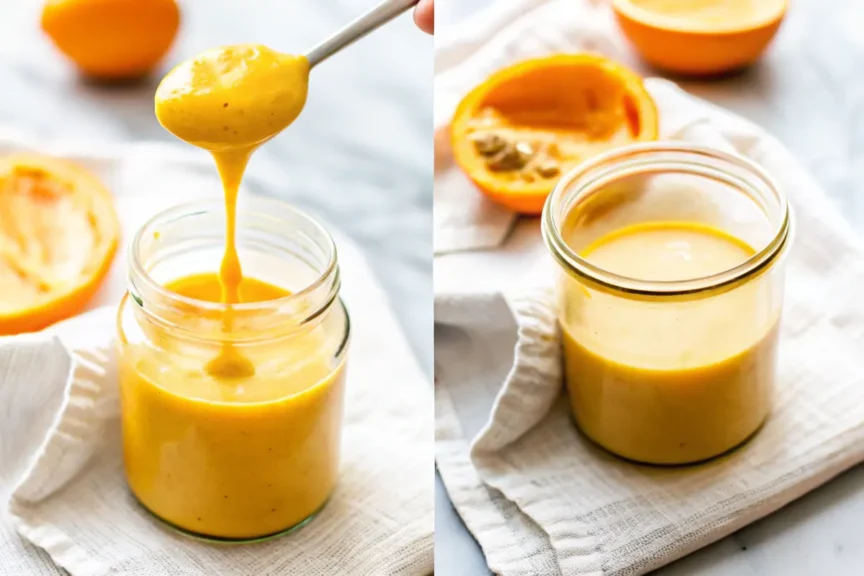
FAQ Section
What is vegan cheese made from?
Vegan cheese is typically made from plant-based ingredients such as nuts (cashews, almonds), seeds (sunflower, pumpkin), soy, tapioca starch, nutritional yeast, and vegetables like potatoes and carrots. These ingredients are blended and seasoned to replicate the flavor and texture of traditional cheese.
What replaces milk in vegan cheese?
In a vegan cheese sauce recipe, plant-based alternatives like almond milk, cashew milk, coconut milk, or even vegetable broth replace traditional dairy milk. These liquids add creaminess and help blend the other ingredients into a smooth sauce.
How do you get vegan cheese to melt?
To achieve a melty texture, use starches like tapioca starch or cornstarch, along with plant-based fats such as coconut oil or cashew cream. Cooking the mixture over low heat while stirring helps the sauce thicken and stretch, giving it that gooey texture.
Does vegan cheese melt like cheese?
While vegan cheese doesn’t melt exactly like traditional cheese, it can come very close. Some commercial brands use specific starches and fats to create a melty effect, while homemade vegan cheese sauce recipes can achieve a creamy, spreadable consistency that’s perfect for pasta or nachos.
Is vegan cheese healthy?
Yes, vegan cheese can be a healthier alternative to dairy-based cheese. It’s typically lower in saturated fat, cholesterol-free, and made from nutrient-dense ingredients like nuts, seeds, and vegetables. Additionally, it’s suitable for those with lactose intolerance or allergies to dairy.
Will vegan cheese ever taste like real cheese?
Some vegan cheeses come very close to mimicking the flavor of dairy cheese, especially those made with fermented ingredients or aged nut-based methods. While it may not taste identical, many people find it delicious in its own right. The key is using umami-rich ingredients like nutritional yeast, miso paste, and garlic for depth of flavor.
Conclusion
Mastering a vegan cheese sauce recipe is a rewarding experience for anyone looking to enhance their plant-based meals. With the right ingredients and a little creativity, you can create a sauce that’s just as satisfying as its dairy counterpart—minus the cholesterol and saturated fat. Use it in pasta, tacos, grain bowls, or as a dip for a healthier and more sustainable alternative to traditional cheese sauces. Try the variations, experiment with flavors, and enjoy the versatility of this delicious sauce!
Looking for inspiration? Try these Vegan Korean Recipes

